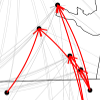How does socio-economic and demographic dissimilarity determine physical and virtual segregation?
Keywords:
Boston, edge weights, followers, income, mobility, network, spatial segregation, Twitter, US, virtual segregationAbstract
It is established that socio-economic and demographic dissimilarities between populations are determinants of spatial segregation. However, the understanding of how such dissimilarities translate into actual segregation is limited. We propose a novel network-analysis approach to comprehensively study the determinants of communicative and mobility-related spatial segregation, using geo-tagged Twitter data. We constructed weighted spatial networks representing tie strength between geographical areas, then modeled tie formation as a function of socio-economic and demographic dissimilarity between areas. Physical and virtual tie formation were affected by income, age, and race differences, although these effects were smaller by an order of magnitude than the geographical distance effect. Tie formation was more frequent when "destination" area had higher median income and lower median age. We hypothesize that physical tie formation is more "costly" than a virtual one, resulting in stronger segregation in the physical world. Economic and cultural motives may result in stronger segregation of relatively rich and young populations from their surroundings. Our methodology can help identify types of states that lead to spatial segregation, and thus guide planning decisions for reducing its adverse effects.

Downloads
Published
Issue
Section
License
Copyright (c) 2020 Michael Dorman, Tal Svoray, Itai Kloog

This work is licensed under a Creative Commons Attribution 4.0 International License.
Articles in JOSIS are licensed under a Creative Commons Attribution 3.0 License.
